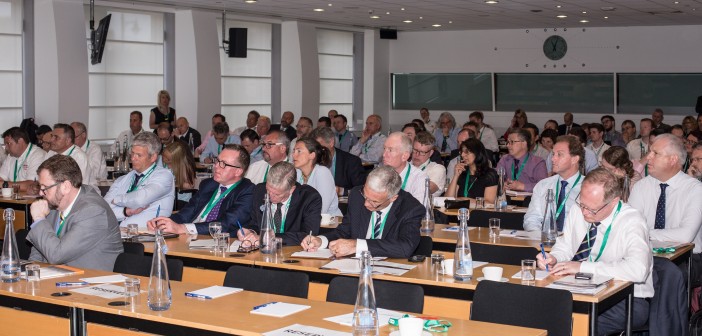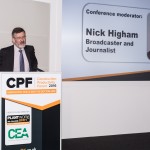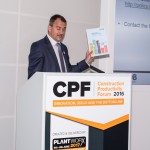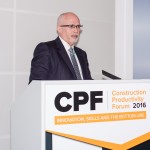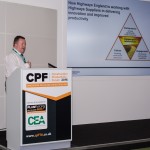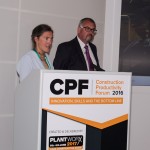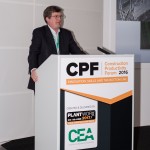The recent CPF (Construction Productivity Forum) inaugural conference (8th June Inmarsat Conference Centre London), supported by Terex and T.C.P. (Taylor Construction Plant), was well attended with over 150 delegates from the Construction Equipment sector.
Jointly hosted by the CEA and Plantworx, Innovation, skills and raising productivity were amongst the topics discussed alongside infrastructure and technology. Keynote speaker, Lord Adonis Chair of the National Infrastructure Commission, gave a fascinating insight into the challenges facing the UK’s construction and civil engineering industries.
Kicking off the conference proceedings was broadcaster and journalist Nick Higham who has been the MC at several past CEA Conferences and CEA Chief Executive Rob Oliver.
First to take the stage was Paul Nash Senior Vice President CIOB (Chartered Institute of Building) who spoke about construction’s problem with productivity in the UK. Mr Nash reported that UK construction productivity has improved by 7% in the last two decades. However, this is well behind other industry sectors, and drags down the productivity performance of the UK as a whole.
As an industry we undertake more repair, maintenance and improvement (RMI) and less new build. Mr Nash stated that RMI is much more labour intensive in productivity terms.
Investigating ways to improve productivity in construction CIOB surveyed the industry and MPs. Both groups ranked investing in people as the top way to improve productivity, with the economy and innovation making up the top three most supported areas. Industry structure and investment in plant and machinery were some of the lowest priorities.
In terms of policy options, the National Infrastructure Commission received significant support among both MPs of all parties and industry, as well as a commitment to boost public investment in construction during a recession.
Other priorities identified in the CIOB survey were more off-site manufacturing, more emphasis on design upfront, more and better training, better communication, management and leadership on-site. Higher earnings in the workforce was also a priority as well as emphasis on BIM and digital innovations.
Next up was Roger Bailey Asset Management Director, Thames Tideway who spoke about how Tideway is upgrading London’s sewerage system to cope with the demands of the city into the 22nd century.
Mr Bailey reported that after years of study, construction work for the new 25 kilometre interception, storage and transfer tunnel running up to 65 metres below the river, known as the Thames Tideway Tunnel, will start this year.
Starting in west London, the main tunnel generally follows the route of the River Thames to Limehouse, where it then continues north-east to Abbey Mills Pumping Station near Stratford. There it will be connected to the Lee Tunnel, which will transfer the sewage to Beckton Sewage Treatment Works.
Overflows of untreated sewage into the tidal River Thames add up to tens of millions of tonnes every year. This is unacceptable and also contravenes the European Urban Wastewater Treatment Directive.
By intercepting the sewage before it enters the river, the Thames Tideway Tunnel will help prevent the tidal River Thames from being polluted with untreated sewage which can stay in the river for up to three months before the ebb and flow of the tide finally takes it out to sea.
Built from three main construction drive sites in Fulham, Battersea and Southwark, the Thames Tideway Tunnel is expected to take up to seven years to build, at a cost of £4.2 billion (2014 prices). It will require the use of 24 construction sites, 11 of which are located along the river bank.
Keynote speaker Lord Adonis Chair of the National Infrastructure Commission addressed the delegates on the UK’s infrastructure and the housing crisis. Lord Adonis opened his speech with “The critical weakness that we have had as a country, over the last generation, has been the inability to take long term positions over planning and national infrastructure – that nearly brought London to a halt 15-years ago and the transport system came close to collapse.”
Lord Adonis reported the same for airport capacity, energy and housing, he said, “We have a housing crisis caused primarily by the inability to build anything like the amount needed to serve the population increases – and we need to put that right.”
He also went on to say that the transport infrastructure had improved over the last fifteen years and is quite impressive using examples such as Crossrail, the Congestion Charge the tube network, the doubling of the bus network, completion of HS1 and of course the Olympics!
“What we need to do as a country now, given we have a significant track record of success in many areas, particularly in the development of major transport infrastructure in London and other areas is to copy the best and start taking decisions in a big way over infrastructure needed over a 25-30-year time period, not just in London but other parts of the country too and get the support, commitment and cooperation from government.
It’s then over to you (Construction Supply Chain) to deliver to see we get the best possible efficiency and productivity in the delivery, which will be enhanced by having a clear supply chain.” Said Lord Adonis
To listen/watch Lord Adonis full presentation, visit https://youtu.be/mGnKyR8NUvE
Sam Stacey Head of Innovation Skanska was the final speaker before the lunch break. “So, the future of construction. I may be wrong, but I don’t see radical changes in the design of the built environment in the near future. What I do see is a revolution in the way it is delivered, and that is something in which all of us are involved.” Said Mr Stacey
“The situation today is both a problem and an opportunity. I think we can accept that technology is the key driver in the improvement of people’s lives. It is at the heart of improvements in productivity, health and business profits. It is also true that the rate of technological change we experience in construction is nothing like what we see in most other industries. This is not really because we lack opportunities for advancement, but more that we do not choose to make the investment and cultural change required to make rapid progress. There are many ways that we can work smarter, and there are many new products and services that we can offer to customers if we plan to do so.
As a cutting edge contractor, Skanska is working on a range of projects, with the likes of ABB to develop robotics for construction, using Oculus Rift virtual reality glasses to show clients how the project will progress and incorporating RFID technology to provide monitoring on site.
One of the biggest potential developments for the contractor comes from what it calls flying factories. While the benefits of off-site construction are well known, transportation costs from production facilities can make them expensive. Skanska has therefore developed temporary pop-up factories, that can be established a short distance from the site.
“We’ve come up with a method called flying factories. Once you get things off site you can start looking at automation,” said Mr Stacey.
New technologies include using robots to make reinforcing cage structures, looking at the automation of piling rigs and using drones to survey structures. Skanska is also working with Loughborough University, Foster & Partners, Lafarge, ABB and others to develop 3D concrete printing. This allows the contractor to create difficult shapes and structures in concrete by printing the design.
“We’re pretty confident that facades will be a big thing, though in small quantities,” said Mr Stacey. “I think there will be a combination of printing on site and in the factory. It’s going to be quite a mission to get consistency across the industry, but this will all help to attract young people into our industry.”
David O’Neil Head of Supply Chain Management, Highways England spoke about boosting innovation and productivity through effective supply chain engagement and how Highways England is working with Highways Suppliers in delivering this.
Mr O’Neil said, “We have an unprecedented challenge ahead! During RIS 1 government will invest £11 billion to deliver – 112 major improvements, including 15 smart motorway projects. A more accessible road system with over 150 new cycling facilities and crossings.
At Highways England we plan to maximise network availability and reduce the impact of incidents and recurrent congestion. Provide more effective and real time information to influence travel patterns and invest to increase capacity and remove bottlenecks to ensure a free-flowing network.”
Mr O’Neil added, “We have big ambitions and safety of users and workers is our primary driver: Our aim is developing and deploying technology to prevent, detect and monitor incidents. Use designated safety funding to deliver targeted safety improvements and eliminate crossings of live carriageways by road workers.”
Talking about the Supply Chain Strategy and how Highways England and Highway Suppliers will work together Mr O’Neil said, “We are aligning around clear and transparent shared objectives and engaging on structures (contracts/environment) to deliver performance and improvement. We are also committing to develop and deliver the capability and capacity.”
Sian James Head of Innovations, Mabey Holdings and Shaun Chivers Special Projects Manager, Mabey Bridge delivered their presentation as a ‘double act’! Mabey is a leading provider of bridging and non-mechanical construction and maintenance equipment and the company specialise in innovative approaches to infrastructure construction.
Ms James explained the procurement challenge, “Early Contractor (ECI) Involvement helps the project delivery process through bringing design queries earlier in the process.
It is not without risk for contractors, as they may put significant effort and added-value into assisting with design revisions and then still lose the tender.”
Mr Chivers said, “Standardise design leads to significant productivity gains – avoid unnecessary uniqueness. This results in lead time improvement minimises design, manufacture and build costs. With standard product the problem of queries and revisions have been removed. The biggest challenge with standardizing a design is cultural change”
Next up was Karsten Elles, Business Development Manager Komatsu who introduced to the delegates Komatsu’s Intelligent Machine – Smart Construction – Managing Machines and Data. “Topcon and Komatsu have come together to create something truly amazing. High-end Topcon technology combined with state of the art Komatsu machines. The result are our i-Machines. The I stands for intelligent, innovative and integrated – Komatsu’s Intelligent Machine Control”. Said Mr Elles
Mr Elles explained how ‘Intelligent’ machine control could save valuable time and money on jobsites whilst taking the pressure off the operator. The machines are incredibly accurate and can be operated by ‘less skilled’ operators.
There are safety advantages too in using intelligent machine control – surveyors do not need to be around the machine. No special arrangements need to be made for deep trenches and working hours are extended as reduced visibility does not impede the operation of the machine.
David Livingstone, Market Adviser, Satellite Applications Catapult of the UK’s High Value Manufacturing government-backed apprentice scheme Catapult talked about how Catapults are bridging the gap between business and academia, helping to turn great ideas into reality, by providing access to world-class research and development facilities and expertise that would otherwise be out of reach for many businesses in the UK.
Rapid progress has been made by Innovate UK in creating the Catapult network. David explained Catapult’s responsibility to utilise high-quality research and development facilities, in tandem with the construction industry, to turn ideas into commercial applications.
The final speaker of the day was Paul Gudonis, VP Sales, Enterprise Inmarsat – he delivered his presentation on delivering safety and control throughout the construction site using satellite technology and developing communications where terrestrial networks are unreliable or don’t exist.
Mr Gudonis said, “By creating the “Connected Site” businesses benefit from real time visibility and control of assets. Telemetry and remote diagnostics of heavy machinery and secure and reliable communications for increased efficiency. Also ensuring the welfare and well-being of your staff.”
The CPF Conference was also supported by Department for Business Innovation & Skills, Build UK, CIOB (Chartered Institute of Building), CECA and CPA (Construction Plant-hire Association).
A full report on the CPF Conference 2016 will be in the next issue of the CEA’s Construction WorX magazine coming soon. To subscribe for free contact Molly Stirling at molly.stirling@admin.co.uk
- Nick Higham CPF Conference Moderator
- Rob Oliver Chief Executive CEA
- Paul Nash CIOB
- Roger Bailey Thames Tideway
- Lord Adonis
- Sam Stacey Skanska
- David O’Neil Highways England
- Sian James & Shaun Chivers Mabey
- Karsten Elles Komatsu
- David Livingstone Catapult
- Paul Gudonis Inmarsat

